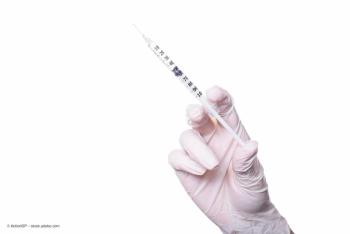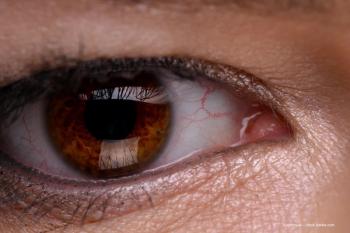
IL-6 inhibition shows promise as treatment for non-infectious uveitis
In a placebo-controlled phase 2 study of patients with severe non-infectious uveitis involving the posterior segment, subcutaneous sarilumab (Kevzara, Sanofi/Regeneron) demonstrated promising therapeutic activity.
Palo Alto, CA-Results from SATURN, an exploratory phase 2 study, suggest that sarilumab (Kevzara, Sanofi/Regeneron), a human monoclonal antibody directed against the alpha subunit of the interleukin-6 (IL-6) receptor complex, may be an effective treatment for controlling inflammation, improving vision, and resolving macular edema in patients with severe non-infectious uveitis involving the posterior segment, said Quan Dong Nguyen, MD, MSc.
“Based on the findings from the phase 2 clinical trial, further studies are indicated to confirm the therapeutic role of sarilumab and IL-6 inhibition in the management of uveitis,” said Dr. Nguyen, Professor of Ophthalmology, Byers Eye Institute, Spencer Center for Vision Research, Stanford University, Palo Alto, CA.
Outcomes from SATURN were published online in October 2018 [Heissigerová J, et al. Ophthalmology. 2018 Oct 11. Epub ahead of print]
Interest in IL-6 inhibition as treatment for non-infectious uveitis is based on several lines of evidence. IL-6 is known to cause ocular inflammation. In addition, this cytokine and/or its soluble receptor have been detected in the vitreous and aqueous humors of patients with active intermediate or posterior uveitis, and in an animal model, treatment with an anti-IL-6 antibody was effective for suppressing the development of experimental autoimmune uveoretinitis. In 2011, an initial clinical publication described efficacy of IL-6 inhibition with tocilizumab (Actemra, Genentech) in two patients with uveitis that was refractory to anti-TNF-alpha therapy, and subsequently, additional papers described positive data from retrospective cohort studies.
The SATURN study investigating sarilumab was an international, multicenter study that randomized 58 patients 2:1 to subcutaneous treatment with sarilumab 200 mg every 2 weeks or placebo. Eligible patients had to be receiving a stable dose of systemic steroids ≥15 mg/day prednisone equivalent alone or in combination with methotrexate ≤ 25 mg/week.
The primary endpoint that evaluated a 2-step reduction in vitreous haze (VH) score or a steroid-sparing benefit (dose reduction to <10 mg prednisone equivalent) was analyzed at week 16. In an open-label extension phase continuing to week 52, patients originally randomized to placebo were eligible to receive rescue therapy with sarilumab.
Dr. Nguyen indicated that the demographics characteristics of the enrolled patients were consistent with a typical uveitis population and balanced between the two study groups. Patients had a mean age of 40 years and there were more females than males. Mean duration of uveitis activity was almost 4 years.
At baseline, 60% of patients had a VH score ≥2, and the mean VH score for the entire population was 2.2. Mean baseline BCVA was 72 letters, mean central retinal thickness (CRT) was 327 microns, and about half of patients had a baseline CRT ≥300 microns.
Analysis of the week 16 data showed that the proportion of patients achieving the primary endpoint was numerically higher in the sarilumab arm compared with the placebo arm whether the VH assessment was done by the investigator or the reading center. Secondary efficacy analysis showed that BCVA had improved from baseline in both study groups at week 16, but the mean improvement was more than 2-fold greater in the sarilumab arm compared with the control group. A difference favoring sarilumab was maintained at week 52.
Subgroup analyses were also performed that included patients with a thicker retina at baseline (CRT ≥300 microns). Among these patients who were also likely to have poorer baseline BCVA, treatment with sarilumab was associated with an even greater benefit at week 16 and further improvement at week 52, Dr. Nguyen reported.
CRT decreased by almost 50 microns at week 16 in sarilumab-treated eyes and by about 70 microns at week 52, but it was relatively unchanged in the control group throughout the 52 weeks of follow-up. Again, the benefit of sarilumab was magnified in the subgroup analysis of eyes with a baseline CRT ≥300 microns.
The safety review of serious adverse events during the 52-week study showed that sarilumab treatment was associated with one case of marginalized neutropenia (2.6%). “Marginalized neutropenia is a well-known adverse event associated with IL-6 inhibition. In this condition, the neutrophils do not necessarily disappear from the body and they often shift back into the circulation after the medication is stopped,” Dr. Nguyen explained.
Results from a 6-month prospective study investigating tocilizumab for the treatment of uveitis also support benefit for IL-6 inhibition Sepah YJ, et al. Am J Ophthalmol. 2017;183:71-80.]. The data from the trial, STOP-UVEITIS, showed benefits for improvements in vitreous haze, BCVA, and macular edema.
Disclosures:
Quan Dong Nguyen, MD, MSc
E: ndquan@stanford.edu
Dr. Nguyen serves on the Scientific Advisory Board for and receives research grant support from Regeneron Pharmaceuticals, and he is a scientific advisor to and/or receives grant support from other companies marketing or developing treatments for uveitis.
Newsletter
Keep your retina practice on the forefront—subscribe for expert analysis and emerging trends in retinal disease management.












































